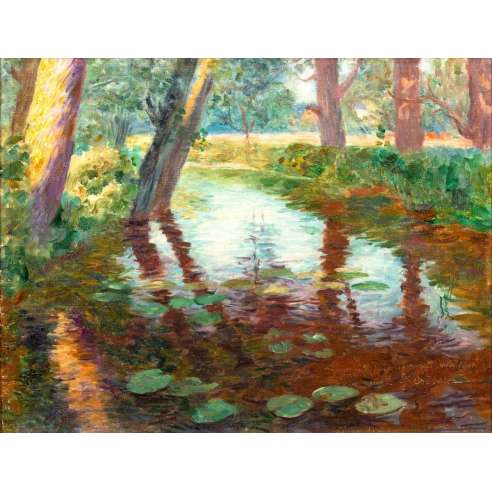Paul-Édouard Crébassa’s painting is a beautiful example of post-impressionist art, showcasing his ability to blend detailed observation with expressive techniques to capture the ephemeral beauty of nature. The painting invites viewers to appreciate the quiet, reflective moments found in natural settings.
The painting captures a serene natural scene, a slow-moving stream surrounded by lush greenery. The composition is balanced, with trees leaning inwards towards the centre, creating a natural frame for the water body. The foreground features the reflective surface of the water, adorned with floating lily pads. The reflections of trees and light on the water add depth and complexity to the composition. The background fades into a bright, sunlit landscape, suggesting an open field or a continuation of the forest. The interplay between light and shadow creates a dynamic yet tranquil atmosphere.
Crébassa employs a rich, natural palette dominated by greens, yellows, and browns. The use of vibrant colors in the foliage contrasts with the softer, more muted tones of the reflections in the water. The painting features a masterful use of light, with sunlight filtering through the trees, casting dappled shadows on the ground and water. This effect adds realism and enhances the peaceful mood of the scene. The reflection of trees in the water is depicted with varying hues and shades, capturing the movement and distortion caused by the water’s surface. This technique highlights Crébassa's skill in portraying natural elements authentically.
Crébassa’s brushwork is fluid and expressive, particularly in the depiction of the water and foliage. The strokes are both deliberate and loose, allowing for a realistic yet impressionistic rendering of the scene. The texture in the painting is achieved through layered brushstrokes, giving depth to the trees and foliage while maintaining a smooth, reflective quality in the water. This textural variation adds to the tactile sense of the scene. The painting shows clear influences of the Impressionist movement, particularly in its focus on capturing light and atmosphere. The loose brushstrokes and vibrant colour palette are characteristic of this style.
The overall mood of the painting is one of tranquillity and serenity. The calm water and the gentle interplay of light and shadow evoke a peaceful, almost meditative state. Crébassa effectively captures the beauty of a natural, untouched landscape. The detailed rendering of the flora and the reflective water surface emphasizes the harmony and simplicity of nature.
The painting likely a scene familiar to Crébassa, possibly from the French countryside, reflecting his connection to the natural landscapes of his homeland.
This painting is dedicated to Louis Nicolas Matout (1811-1888), who was a renowned French painter and muralist, known primarily for his cityscapes, genre scenes, and historical murals, as is evidenced by the inscription. "Au grand pêcheur Louis Matout mon ami." This highlights the mutual respect and camaraderie shared among artists of that period.




















